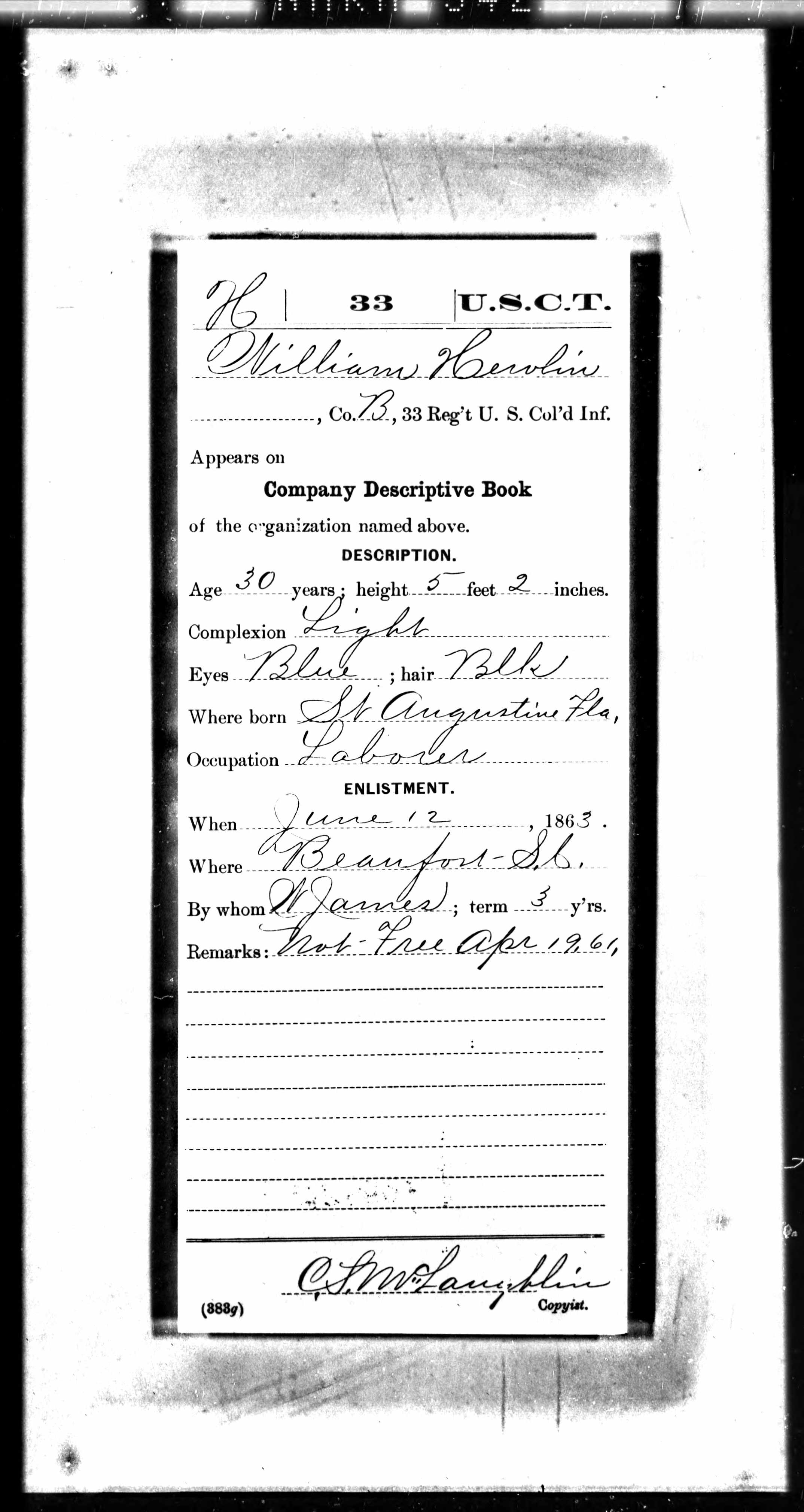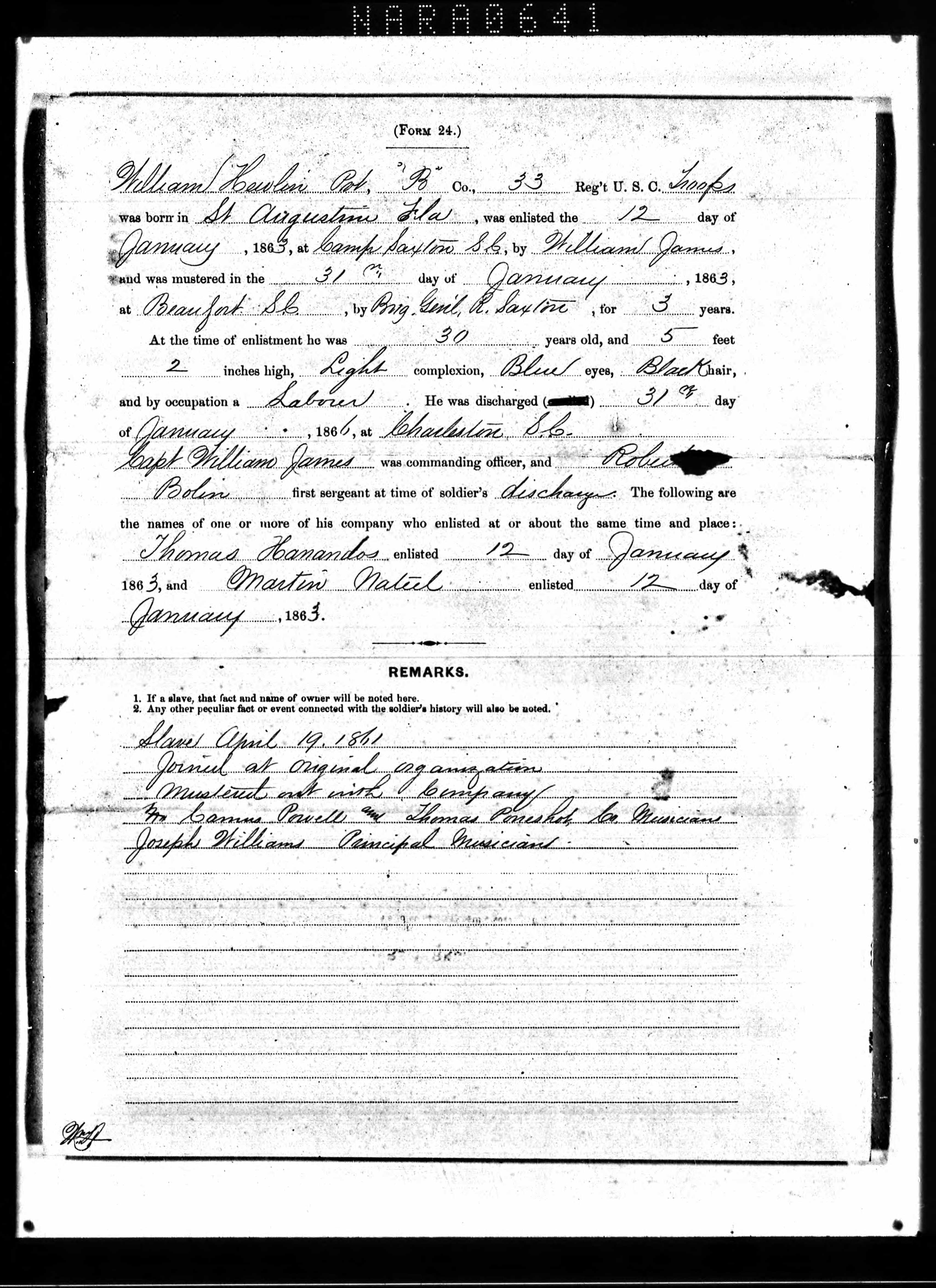William Hewlin (c. 1833–c. 1890)
By Sara Nazarian
During the Civil War, William Hewlin served as a Private in the Thirty-third United States Colored Infantry (USCI). Born in Saint Augustine, Florida, he was a slave as of April 19, 1861. Hewlin ran away to South Carolina and worked as a laborer before entering service.1
After the seceded states of the Confederacy bombarded Fort Sumter, the war began. Initially, the government rejected the service of African Americans because the war was about maintaining the Union with slavery. On September 22, 1862, President Abraham Lincoln issued the preliminary Emancipation Proclamation. It went into effect January 1, 1863, prompting the Army to recruit black soldiers. In Beaufort, South Carolina, former slaves gathered to hear the reading of the final proclamation on January 12, 1863 at Camp Saxton. On the same day, Hewlin enlisted into the Company B, First Regiment South Carolina Volunteer Infantry at the age of thirty, as seen here. He was mustered in on January 31, 1863, the same day the regiment was officially formed, for a period of three years. The regiment went on to capture Jacksonville, Florida on March 10, 1863.2
Like other African American soldiers, Hewlin was paid less than white soldiers. From the time of his enlistment to February 28, 1863, he received thirteen dollars a month, the same pay as white soldiers. From February 28 to October 31, his monthly salary was reduced to ten dollars and then reduced a further three dollars for clothes. He received his full pay back on June 15, 1864 after Congress passed a bill equalizing pay for black soldiers.3
On January 19, 1864, Hewlin was granted an official absence on furlough and allowed to return to Saint Augustine. During his absence on February 7, 1864, he married his wife Victoria. Afterwards, he returned to the regiment to serve out the rest of his enlistment.4
The day after his marriage, the First South Carolina Volunteer Infantry was designated the Thirty-third United States Colored Infantry (USCI). The regiment participated in the capture of the Battery Gregg on James Island, South Carolina near Charleston and the Battle of Honey Hill, South Carolina. During its last year of service, the regiment was part of the Union garrison of Savannah and Charleston. Hewlin was mustered out in Charleston, South Carolina on January 31, 1866. He owed the United States government $1.60 in equipage fees and the US government owed him $34.05.5
After the war, Hewlin applied for provisions at the Freedmen's Bureau. On his application he included fellow war veterans Thomas Hanandos and Martin Nateel, as seen here. Hewlin started receiving an Army pension in 1878 and later returned to Saint Augustine with his wife and settled there. As of 1880, Hewlin worked as a drayman⎯a person who drove a flat-bed wagon or cart without sides pulled by horses or mules to transport goods. He lived in an area the census called the “Colored Settlement.” He and his wife had four children: George, John, Cato, and Julia. Although there is no official record of his death, it is probable that Hewlin died sometime before or during the year 1890. He was interred at the Saint Augustine National Cemetery in Section A, Grave Number 185. His name also appears on the African American Civil War Memorial on plaque B-49.6
Endnotes
1 “U.S., Colored Troops Military Service Records, 1863-1865,” database, Ancestry.com (https://ancestry.com: accessed July 16, 2019), entry for William Hewlin.
2 Matthew Pinsker, “Emancipation Among Black Troops in South Carolina,” Emancipation Digital Classroom, accessed July 16, 2019, http://housedivided.dickinson.edu/sites/emancipation/2012/11/06/emancipation-among-black-troops-in-south-carolina/; “U.S., Colored Troops Military Service Records, 1863-1865,” Ancestry.com, William Hewlin; “Guide to the 1st South Carolina/ 33 Rd U.S. Colored Troops Records,” database, Online Archive of California (https://oac.cdlib.org: accessed July 16, 2019).
3 “U.S., Colored Troops Military Service Records, 1863-1865,” Ancestry.com, William Hewlin; “Sergeant Francis Fletcher of the 54th Massachusetts on equal pay for black soldiers, 1864,” History Now, The Gilder Lehrman Institute of American History, accessed July 22, 2019, https://www.gilderlehrman.org/content/sergeant-francis-fletcher-54th-massachusetts-equal-pay-black-soldiers-1864. “Florida Marriages, 1837-1974,” database, Ancestry.com (https://ancestry.com : accessed July 16, 2019), entry for William Hulen.
4 “U.S., Colored Troops Military Service Records, 1863-1865,” Ancestry.com, William Hewlin; “Florida Marriages, 1837-1974,” database, Ancestry.com (https://ancestry.com : accessed July 16, 2019), entry for William Hulen.
5 “Guide to the 1st South Carolina,” Online Archive of California; “U.S., Colored Troops Military Service Records, 1863-1865,” Ancestry.com, William Hewlin.
6 “United States, Freedmen’s Bureau Claim Records, 1865-1872,” database, FamilySearch.org (https://www.familysearch.org : accessed July 16, 2019), entry for William Hewlin; “U.S., Civil War Pension Index: General Index to Pension Files, 1861-1934,” database, Ancestry.com (https://ancestry.com : accessed July 16, 2019), entry for William Hewlin; “dray,” Merriam-Webster Dictionary, accessed July 31, 2019, https://www.merriam-webster.com/dictionary/dray; “1880 United States Census,” database, Ancestry.com (https://ancestry.com : accessed July 16, 2019), entry for William Hewlin; “U.S. National Cemetery Interment Control Forms, 1928-1962,” database, Ancestry.com (https://ancestry.com : accessed July 16, 2019), entry for William Hewlin; “ U.S. Civil War Soldiers, 1861-1865,” database, Ancestry.com (https://ancestry.com : accessed July 16, 2019), entry for William Hewlin.
© 2019, University of Central Florida




